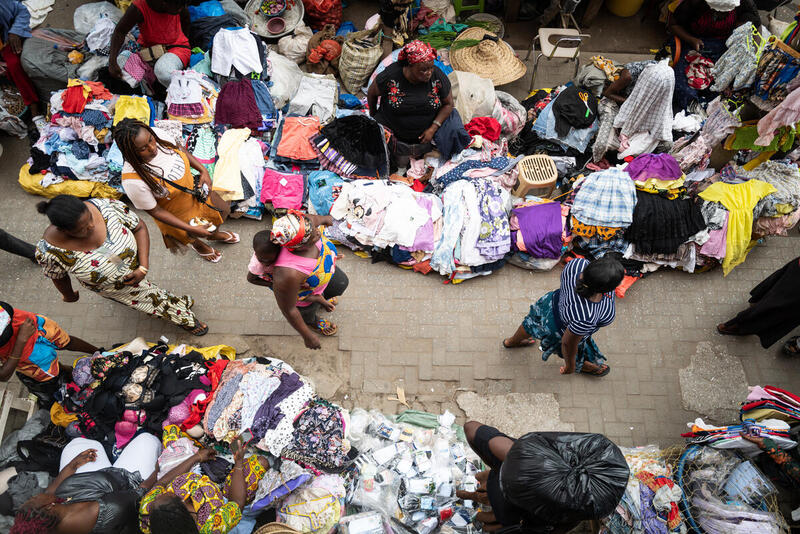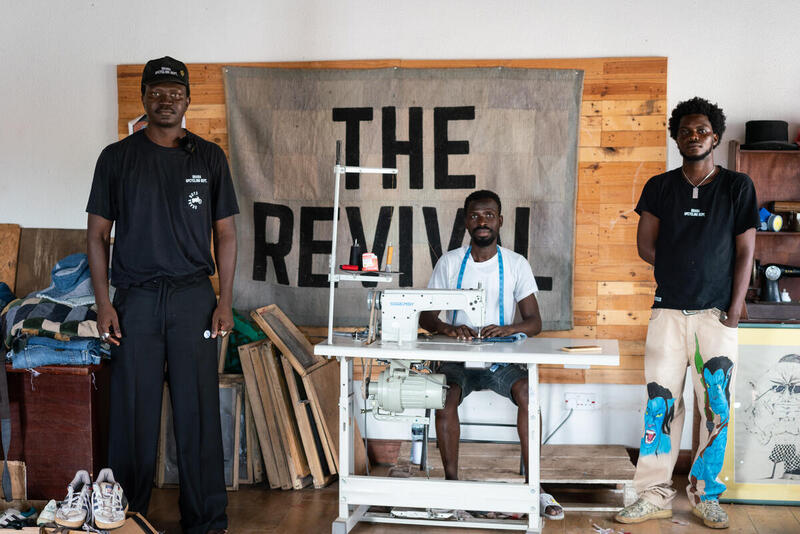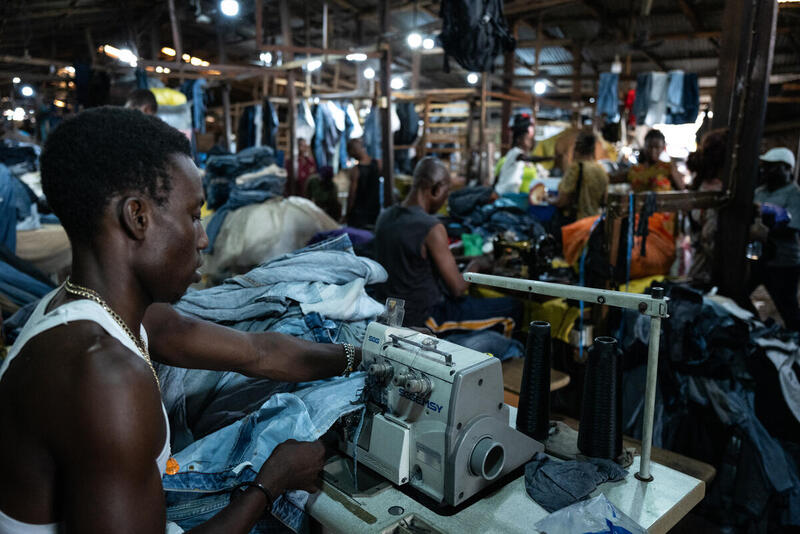On the night of Jan. 1, a blaze tore through Kantamanto Market in Accra, Ghana, claiming the life of two traders and displacing over 8,000 others. The fire reduced livelihoods to ashes, reigniting urgent conversations about Ghana’s decades-long struggle managing textile waste from the Global North.
“[The sellers] stood silently, gazing at the charred remnants of their shops,” Natalija Gormalova, a photographer who documented the aftermath of the fire, told Forbes. “Questions hung in the air: Who bears responsibility for this tragedy? Why have fires plagued the market so frequently in recent years? And most pressing of all, who will help them rebuild?”
Ghana has been plagued by a growing textile waste crisis ever since it was forced to open its doors to second-hand clothing imports from Europe and North America in the mid-1900s. The country was freshly independent from the British Empire and needed ways to boost its economy. This grew to include fast fashion brands like Zara and Shein. Ghana soon became a dumping ground for millions of dollars worth of second-hand clothing.
As Kantamanto Market rebuilds, campaigners are urging fashion brands like Zara and H&M, whose clothing is sold at the market, to foot the bill. Some Ghanaian fashion leaders are pushing for creative ways to put unwearable clothes to use, but funding problems — plus a growing volume of unwearable clothing — are putting those efforts at risk.

A Ghanaian fashion designer’s solution
Miles away from the dusty and humid Kantamanto Market, at the Victoria & Albert Shop in the U.K., a denim patchwork tote bag hangs inside a blue cubby. Beneath it, an electronic tablet depicts some prototype images of the bag with a description typed out in white-coloured font, chronicling the bag’s origins.
The Victoria & Albert Shop’s denim tote bag was once a pair of denim jeans, dumped as waste on the muddied grounds of Kantamanto Market. It’s from here that Yayra Agbofah begins his crusade against waste colonialism.
Every week, as the sun rises, Agbofah’s team arrives at Kantamanto Market in search of denim jeans and other clothing waste. Kayayei, or head porters, carry bales of clothing around the market, rigorously bleach dirt off the clothes and lay them out to be sun-dried, before neatly folding them back inside their plastic carrier bags, ready to be distributed among Kantamanto Market tailors. What’s left is driven to Agbofah’s studio.
A local Ghanaian fashion designer and businessman, Agbofah co-founded The Revival in 2018, hoping to undo the decades of environmental damage an influx of unsellable second-hand clothing had caused to his home country.
Since it began, the community-led textile upcycling organization has struck international deals with institutions like the Victoria & Albert Museum. It also teaches its upcycling expertise to future fashion students at pop-up workshops in London, Amsterdam and beyond. In the last two years, it has upcycled 1 million garments and created new jobs, employing seamstresses, tailors and artists from the local community.
Today, The Revival is seeking ways to use textile waste to fix other problems in Ghana. In 2023, the group weaved together protective jackets and gloves out of denim — which is unwearable in Ghana’s hot climate — for pineapple farmers, who are susceptible to burns and rashes when out on the field.
With funding generated from his organization’s work, Agbofah plans to open a new studio and lab on the premises of Kantamanto Market one day, where community members can upcycle their torn and stained clothes. However, his small team of porters, seamstresses, and fashion designers is running out of resources to continue operating.
“We’ll be swallowed (up) with capacity we don’t even have right now. There’s so much waste,” Agbofah tells Analyst News. “I don’t have enough workers. We don’t have enough resources, enough space.”.

The new face of colonialism
Arriving in bulging bales, Ghana receives around 15 million pieces of garment every week. Traders buy the stock intending to sell as much of it as they can at Kantamanto Market.
But as the quality of imported second clothing has dropped, between 40% to 60% of it must be discarded and is often dumped in informal landfills, or it seeps into the local community, polluting lagoons and waterways, clogging beaches and harming aquatic and wildlife.
Traders buy shipments in bulk, many of them taking out vast loans to do so. But when their unsellable stock goes to waste, some find themselves trapped in debt.
North American and European countries have been sending their unwanted second-hand clothing, apparel and electronics to Africa since the mid-1900s, when liberal trading policies were adjusted in programs sanctioned by the International Monetary Fund and the World Bank. As the scale of exports to Kantamanto Market grew, so too did a post-colonial appetite in Ghana for affordable pieces of European-style clothing, known locally as “obroni wawu” — “dead white man’s clothing.”
From Accra to India to the Philippines, the textile waste crisis — also known as waste colonialism — exists throughout the Global South. But in the last two decades, the fast fashion industry’s rampant overproduction has caused a surge in the problem. In 2018, exports from the EU to African and Asian countries climbed to three kilograms per person in the EU, according to the ‘Fast Fashion. Slow Poison’ 2024 report by Greenpeace Africa.
Africa has fast become the largest destination for these unwanted goods. Ghana received $121 million worth of second-hand clothing in 2023, per the Observatory for Economic Complexities, making it the eighth-largest importer of second-hand clothing. With the rise of fast fashion and its resurgent face, ultra-fast fashion, the volume of second-hand clothing is becoming unmanageable.
Fast fashion is a business model which involves rapidly overproducing clothing at low costs; ultra-fast fashion speeds it up even faster. The global business trade in used clothes — which is expected to balloon to $218 billion by 2026, according to the Greenpeace report — has accelerated with the rise of these business models. Fashion brands such as Zara, H&M and Next are among the top 10 manufacturers of most of the unsold stock at Kantamanto Market, the report shows.

Fighting back against waste colonialism
“Ghana is being seen as a dumping ground [with exporters saying] … I’m not getting rid of our own waste within our own countries. Let’s just send it to Africa’, and that’s a big issue,” Sam Quashie-Idun, the lead investigator of the Greenpeace report, tells Analyst News.
Ghana tried outright bans on second-hand clothing imports and attempts to enforce quality control in 1994 and 2020, but both failed. Advocates have also called for regulations that would force offending fashion brands to pay fines per freshly-produced garments, to help deal with the surplus.
“We really need governments and fashion labels to come together on the global stage to really try and fix this issue and not focus so much on profits,” says Quashie-Idun.
Across the continent in East Africa, similar attempts were made to ban second-hand apparel. In 2017, Kenya, Uganda, Burundi and Rwanda tried to ban the import of America’s cast-offs, increasing import tariffs on second-hand clothing. Fighting back, the United States threatened many of them with expulsions from the African Growth and Opportunity Act 2000, which was implemented to spur trade and economic growth throughout sub-Saharan Africa. Many of these countries cowered to the backlash; only Rwanda managed to press on with the ban. But in 2018, the United States hiked its tariff costs for exports from Rwanda as part of the Trump-era ‘America First’ policy, a de-facto sanction on the country for daring to stop second-hand clothing imports. With Trump’s recent return to the White House, Rwanda said it would uphold the ban.
A blanket ban on second-hand clothing exports could hurt the U.S. economy because it would put about 4,000 American jobs at stake, according to the Secondary Materials and Recycled Textiles Association, a group of 40 used clothing exporters, which was behind a petition to derail plans for a ban. The group also worried that a ban would divert textile waste to landfill sites within the United States instead.
At the same time, experts are wary that an outright ban on second-hand clothing exports might “crumble” Ghana’s economy, which relies heavily on jobs created by the second-hand clothing industry. In 2023, it generated $76 million to Ghana’s GDP and created 65, 000 formal and informal jobs, from kayayei or head porters, who transport bales of clothing to Kantamanto Market traders, the business owners to artisans and fashion designers.
“A lot of people’s livelihoods depend on these exports,” says Quashie-Idun. “Please continue sending your [second-hand] clothes to Ghana, but just make sure they’re actually of good quality.”
“Made in Africa” movements
Decades since Africa first began taking in the Global North’s cast-offs, a new generation of fashion designers are reviving the continent’s fashion industry. With authentic, locally sourced materials, woven using traditional techniques like embroidery, tie-dye and hand-weaving, these designers are creating new clothing from scraps of fabric abandoned on the beaches, open fields and landfills of their home countries. From Nigerian culture-influenced fashion brands like Ahluwalia and This Is Us to Osei-Duro in Ghana, sustainable African fashion brands are beginning to emerge on the runways of international fashion shows.
Africa produces large quantities of raw cotton, former fashion designer Jacqueline Shaw previously told the podcast, Unlocking Africa. But farmers export it outside the continent to be processed on an industrial scale, before importing it back at high manufacturing costs, said Shaw, who also founded Africa Fashion Guide, a social enterprising organization which helps the African textile and fashion industry.
African fashion designers are also restricted from competing globally due to high transportation costs; many African countries are landlocked, so transporting locally manufactured products internationally is expensive, as is importing trims like zips, which are usually made in Asia, she said.
At the same time, there is a growing appetite for luxury African wear, known as African Haute Couture, a 2023 UNESCO report suggested, with demand predicted to rise by 42% in a decade. However, a lack of training, infrastructure and funds to process raw material in the continent are restricting the African fashion industry from growing. The fashion industry is worth about $31 billion, making up 1.2% of the global fashion market, hosting up to 32 fashion weeks every year. But for as long as cheap second-hand clothing drains into the continent, local textile and fashion businesses will struggle to compete, say experts.
Away from the vanity and glitz of catwalks, traders at Kantamanto Market are still rebuilding their cherished livelihoods. The Revival set up a fundraiser in the immediate aftermath of the fire. As of March, they’ve raised more than $4,000. But they, like hundreds of Ghanaians, know that this would not be the last fire to devastate Kantamanto Market. As the mountains of second-hand clothing grow taller, cheap materials and ad-hoc methods are used to keep expanding Kantamanto Market, rendering it more and more vulnerable to fires and floods.
A few miles from the market, each time a new tide arrives at Jamestown Beach, more textile waste washes ashore, burying the sand deeper underneath. Out at sea, fishermen tossing their nets to catch fish wind up snagging textile waste instead. In the public wash houses at the nearby settlement of Old Fadama, settlers bathe in barrels of water heated over hearths that are fueled by pieces of discarded fabric, breathing in lethal levels of the toxins they release.
“Without any foreseeable intervention, I see the beaches in Ghana continuing to pile up and pile up and pile up with clothes,” Quashie-Idun says. “I see our rivers and lagoons continuing to get choked up. I see our landfill sites overflowing, overgrowing and pollution just continuing to increase.”

